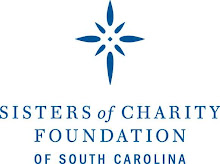One often wonders about how to best serve the poor and
marginalized in our communities. We wonder whether we are maximizing our
resources to have lasting results. Recently, I met “Toxic Charity” author Robert Lupton at a meeting in
Myrtle Beach, S.C. Lupton shed tremendous light on some of the concerns around serving
the poor.
At the Sisters of Charity Foundation of South Carolina, we recognize
a distinct separation between generational poverty and situational poverty, and
how we address them both. We view generational poverty as chronic, with many
variables that have caused a person to live in poverty, including family
structure, community structure, educational attainment, access to health care,
life skills, culture, value and attitudes. We view situational poverty as
crisis poverty. A person is without food, clothing or shelter or in need of
medical attention now but has no health insurance coverage. These two distinctions are very apparent and
both are worthy of the Foundation’s attention and resources. In the Foundation’s
case, more than 85% of our grant funding goes to addressing generational
poverty. We feel we have greater impact in South Carolina addressing
generational poverty, but we also realize that situational and crisis poverty
exists and needs support.
Lupton explained the dilemma faced with providing services
through our government, churches and nonprofit organizations. Lupton believes,
and I agree, that we often apply crisis tactics to chronic problems, even when
the situation is clearly persistent. Applying crisis intervention to a chronic
issue can be harmful to a person or a family and it fosters dependency, which
perpetuates poverty. This is why people who are poor remain poor.
The question becomes “what can we do differently?” Lupton feels
the most important factor missing in most service programs for the poor is that
the recipient has no “skin in the game.” You give them something the first time
and they appreciate it. You give them something a second time and they
anticipate it. You give them something a third time and they expect it. You
give it a fourth time and they depend on it. If you really look closely at a
person in poverty, odds are that they would much rather be a partner or
participant than a charity case. That is
why free clothes closets are not good but thrift stores work. That is why free
food banks foster dependency but inexpensive food co-ops allow the person to
become a customer.
A lot of organizations are trying very hard to do the right
thing for others. This is in no way to criticize the good intentions that
organizations have or the work that they do. This is about looking at those we
want to help, differently. This is about respecting the client and building
their ability to be self sufficient. As Lupton said, “We never do for someone
else what they are capable of doing for themselves.”
Communities and organizations dealing with issues around
poverty must be willing to shift. The United States gives away more food, money
and services than any other country in the world. But rather than just giving
it away, can we find new ways to partner or help individuals become more independent?
If so, they will become respected and confident consumers with a greater sense
of self worth. It will also create an environment where individuals are no longer
viewed as “charity” and where chronic issues are addressed more strategically
and more collegially.
These kinds of changes will have a positive impact on the
entire community. I invite you to read Lupton’s book, “Toxic Charity: HowChurches and Charities Hurt Those They Help (And How to Reverse It).” It will
change the way you look at those you are trying to help. It sure makes sense to
me.
Tom Keith is the president of the Sisters of Charity
Foundation of South Carolina
Note: Learn how one Sisters of Charity Foundation of South Carolina grantee puts Lupton's thoughts into practice. Reverend Bill Stanfield, co-founder and chief executive officer of the Metanoia Community Development Corporation of North Charleston, shared a first-hand example of how to build a strong community using the strengths of the community rather than the deficiencies.



1 comment:
Good to hear it. You can help the needy one. Try this (tfi) the family international
Post a Comment